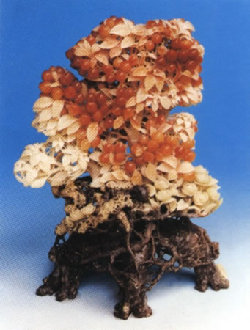Qingtian stone carving is one of the most famous handicraft works Three Carvings and One Statue of China. It originated in Qingtian of Zhejiang Province, a county reputed as the Hometown of Chinese Stone Carvings. With beautiful modeling and refined craftsmanship, Qingtian stone carvings are loved by many people and reputed as the Embroidery on Stones.

Qingtian stone carving is a bright pearl in the art treasury of Chinese traditional stone carvings, and has a long history. The earliest Qingtian stone carving discovered today is the one unearthed in a tomb of the Southern and Northern Dynasties Period (420-581). In the Tang Dynasty (618-907), Qingtian stone carving witnessed a breakthrough development in both subject matters and techniques. By the Song Dynasty (960-1279), artisans had absorbed the technique of jade carving and made use of moderate hardness, beautiful colors and unique texture of Qingtian stones to usher in the multi-layer engraving technique. In the Yuan Dynasty (1271-1368) and the Ming Dynasty (1368-1644), Qingtian stones were applied in seal carving, further expanding the range of stone carvings. By the Qing Dynasty (1644-1911), Qingtian stone carvings had developed into tribute to the emperor and enjoyed great reputation worldwide.

As a traditional refined artwork, Qingtian stone carving has reached unprecedented perfection in carving technique, modeling and artistic conception. Artisans bring into full play their originality and carve the stones according to the original covers and shapes. In Qingtian stone carving, fruits, flowers and vegetables are major subjects. Up till now, Qingtian stone carvings have been exported to over 100 countries and regions.










